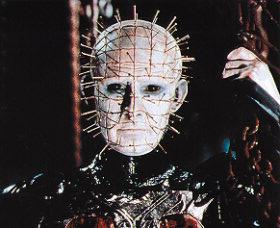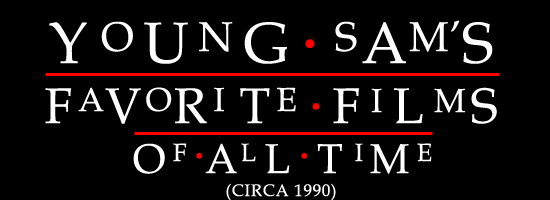No. 13: HELLRAISER

Reviewed by Sam Hatch
AS THIS IS PART OF A RETRO NOSTALGIA BINGE AS OPPOSED TO A TRADITIONAL REVIEW, THERE MAY BE SPOILERS PRESENT IN THE TEXT.
Like many people this film was my introduction to the feverishly inventive mind of author/playwright/filmmaker/artist Clive Barker. Shortly after viewing it I obsessively collected his body of work. Though I was always disappointed that the short story that inspired this film (The Hellbound Heart) was never among the collections of short stories I found. It did eventually gain a release in the U.S., and unlike the inspiration for Clive's later film Lord Of Illusions, the source material is pretty much identical to the film it spawned.
Barker was a fan of the Grand Guignol theater, and Hellraiser feels very much like a stage play. There are a few external shots (many very artful traveling shots where British architecture mirrors the designs of Hell's puzzles) and segments occurring in bars and hospitals, but the bulk of the material takes place in one newly inhabited town house. Andrew Robinson's Larry Cotton decides to move into the abandoned domicile of his deviant/derelict brother Frank, and his daughter Kirsty (Ashley Laurence) decides to visit despite her dislike for her new stepmother Julia (Clare Higgins).
The film is brimming with great ideas, and nobody but Clive Barker could craft a haunted house story like this. (In fact, it's a wonder that so many people puzzle over how Stephen King comes up with his ideas, when his work is terribly mundane compared to Barker's wild innovation) Come to find out, Frank was a very freaky boy, whose obsession with extreme experiences of the flesh (including one dalliance with his brother's new bride-to-be) led him to track down a mysterious Chinese puzzle box known as the lament configuration (or the Lamarchand Configuration at times). When it turns out to be a key to opening portals into Hell, it's a Hell that we've never seen or imagined before. The box summons tortured entities know as Cenobites, and the makeup work on their twisted visages is fantastic. Doug Bradley as Cenobite spokesman 'Pinhead' is the epitome of malevolent force, and his voice (with a bit of audio tweaking) is truly frightening. When he spews forth his trademark line "We'll tear your soul apart", you fear for yours as well the endangered character's.
Not to say that the horror in the film is strictly from nefarious beings from the underworld (or otherworld). A simple furniture-moving scene creates extreme discomfort as Andrew catches his hand on a stray nail and it rends his flesh in a gleeful close-up. His squeamishness is the polar opposite of Frank's deviant joy in pain, and it soon becomes apparent that Julia would much rather be with him than her current husband.
Lucky for her, the house is still haunted by Frank in a fashion, and she manages to free him from his eternal torture at the hands of the Cenobites. These scenes are brilliant, as Frank is reborn with awesome makeup effects transforming him into a skinless entity of dripping red muscle. He needs the life-force of more victims in order to fully recorporealize, so Julia becomes one evil frickin' Lady MacBeth as she roams the city looking for businessman she can lure to the house with the promise of sex. Frank intends to regain his skin and usurp his brother's identity, stealing his life as well as his wife.
The wild card in this scenario is Andrew's daughter Kirsty, who begins unraveling the situation and eventually decides to risk her own soul in a bargain with the Cenobites. Unfortunately, later films in the series cast Pinhead as a Freddy/Jason/Michael horror super villain, which completely robbed the character of his effectiveness. Likewise, the Cenobites in the other films are unimaginative derivatives (CD Head, anyone?) that ruin the terror. The original Hellraiser is unique in spinning the concept that the eternal torture provided by the denizens of Hell is somehow considered pleasurable as well. Granted, Barker just took the concept of sado-masochism and exploded it to infernal dimensions, but it was a bloody brilliant concept.
The one slightly worthy follow-up was Tony Randel's Hellbound-Hellraiser 2, which had some very eerie sets and created the unsettling insane asylum director Dr. Channard. Unfortunately, it all unraveled by the end, but there is still a lot to love in it. I should also mention that both films owe a huge debt of gratitude to the orchestral work of Christopher Young, who much like Black Sabbath with their ominous tri-tone sound (aka Diabolus in Musica), went to great lengths to craft a legitimately demonic score. Track down both soundtrack albums if you can!
